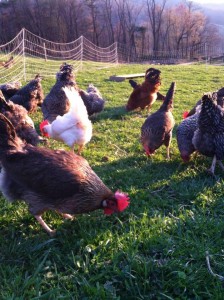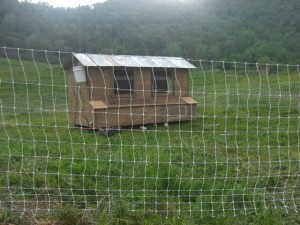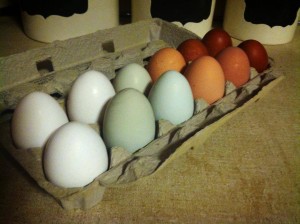Guest Post
by:
Adam Henson of Shady Brook Farm in Canton, NC
When you think of free range, in terms of eggs, what is the image that pops into your mind? For many, that label prompts visions o f happy hens wondering about a farm untethered by cage or fence, to the delight to of their stomachs, looking for scrumptious morsels on which to feast.
f happy hens wondering about a farm untethered by cage or fence, to the delight to of their stomachs, looking for scrumptious morsels on which to feast.
In reality though, free range doesn’t have to mean that at all. According to the United States Department of Agriculture (USDA) Meat and Poultry Labeling Terms, part of the Agency’s online Food Safety and Inspection Service, “free range” or “free roaming” only has to mean, “producers must demonstrate to the Agency that the poultry has been allowed access to the outside.” It doesn’t mean that the hens aren’t crowded in barns designed to hold as many as 20,000 chickens, it only means that if they want to go outside they can. It doesn’t mean the house has more than one access point to the outside for all those hens. It doesn’t dictate the size of the outside area to which the hens are given access or how much time during a 24 hour period they must be outside. All “free range” means, according to the USDA, is that the laying hens, which produced the eggs labeled as such, had access to the outside.
This label then really does nothing to support animal welfare, other than giving proof the hens were not kept in battery cages, nor does it promote the production of eggs with high nutrient value. Instead it is simply a marketing term that even in the best of situations tends to be misleading. So what options do consumers have? Short of raising their own back yard chickens, which isn’t overly hard given the proper preparation, the label consumers should look for is “local”.
The local label is best because it is more than just a term of proximity. It is a movement. It is the mark of a farmer who intends to be on a first name basis with the consumer. When local is what matters, the consumer doesn’t have to rely on a label for information on the production model, only to have to wonder what does that mean exactly. Instead it can be viewed, or at least explained by the producer.
At Shady Brook Farm, in Henson Cove, we do not promote our eggs as free range. Our production model though, goes beyond the USDA qualifiers for this label. Our hens really do work quite hard for us, serving multiple purposes. Of course they produce eggs, which due to our mobile system are of a high quality (that being determined by yolk color) but they are also fertilizing our cattle pasture and are to some extent helping to control fly populations.
Our hens are housed in a mobile coop that is designed to move through our cattle pasture using a tractor. An electric poultry fence surrounds the coop for the protection of our hens from land predators, as well as to ensure the eggs are laid in the coop and can be collected daily. This fence also allows us to control where the chickens fertilize. With this system the hens have 24/7 access to the outside and the whole setup is moved to fresh grass on a regular basis, this helps keep egg quality high as well as benefiting our pasture.
We also make use of smaller pens called “chicken tractors”, which have an open bottom and are placed directly on the ground. These pens concentrate a small group of chickens in a tight area for the specific purpose of amending the ground for the sake of soil fertility. We are currently using this model to improve the fertility of the soil where we garden. Again, this system is moved regularly.
We sell eggs to people who are looking for something more than what the grocery store can provide. The majority of our eggs are sold within hours and/or days of having been laid by the hens instead of weeks. We keep a number of different breeds of chickens so that when you open a carton of our eggs you are greeted by a variety of colors from white to several different shades of brown (even some with an almost chocolate color from our Marans hens) to the blue and green hued eggs of our so called Easter Eggers.
When it comes to labels, don’t be fooled by minimum requirements or clever marketing tricks. Instead invest in yourself and your community by eating locally grown food produced by farmers who are willing to sell to their neighbors and not just food outlets like grocery stores.
Thank you for reading,
Adam Henson
To purchase Shady Brook Farm eggs or for more information, Contact shadybrookgrassfarm@gmail.com
or828.507.5746


